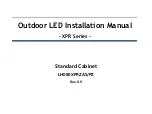1
PerkinElmer Optoelectronics
1 Introduction
1.1 What’s In this Manual
This manual describes the receiving, unpacking and inspection of your LC3000
series camera. Included is a operational overview that defines the camera
operation and the controls provided. Guidance is provided for the installation,
setup and initial operation of your LC3000 camera.
1.2 Purpose
To provide machine vision system engineers and technicians a definitive guide
for integrating LC3000 series cameras into their specific machine vision
application.
1.3 Product Overview
The LC3000 series cameras are designed for linear line scan image capture
applications. 512, 1024 and 2048 pixel line scan image capture is offered at 10,
or 20 megapixels/second depending on the camera model selected. Each camera
uses a PerkinElmer P-series photodiode linear array with 14
mm pixel pitch at a 14
mm aperture. This provides a 54dB dynamic range over a spectral range of 350 to
1000 nm. All camera control functions are selected by corresponding DIP
switches. Digital I/O is provided as differential RS-422. The video output is
differential analog.
1.4 Functional Description
The LC3000 series cameras incorporate high performance, high resolution line
scan image sensors. (PerkinElmer Optoelectronics Imaging Systems parts
RL0512PAG, RL1024PAG, or RL2048PAG) featuring pinned photodiode pixels.
Each photodiode converts incident light into discrete charge packets that are
converted to an analog voltage.
The analog voltage is processed as a single channel sampled and held raster order
analog video data signal. Analog processing circuitry provides adjustable gain
and offset levels allowing the accommodation of unique lighting requirements.
Figure 1 is a block diagram illustrating the major camera components.


















